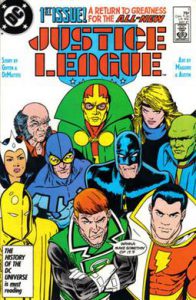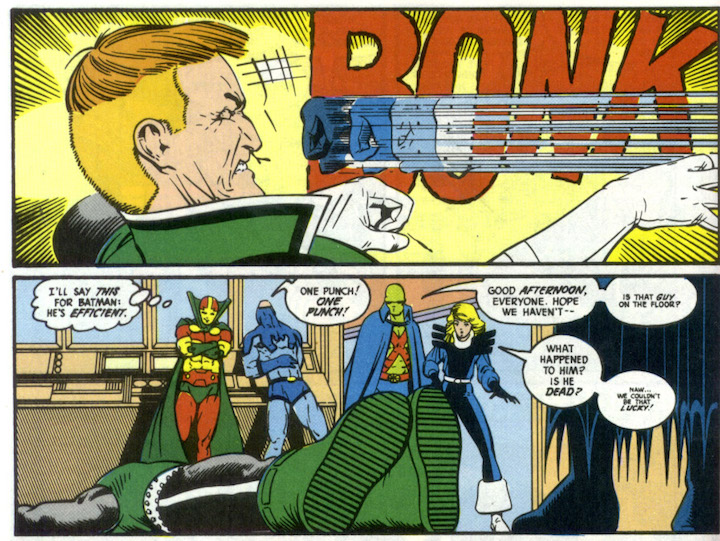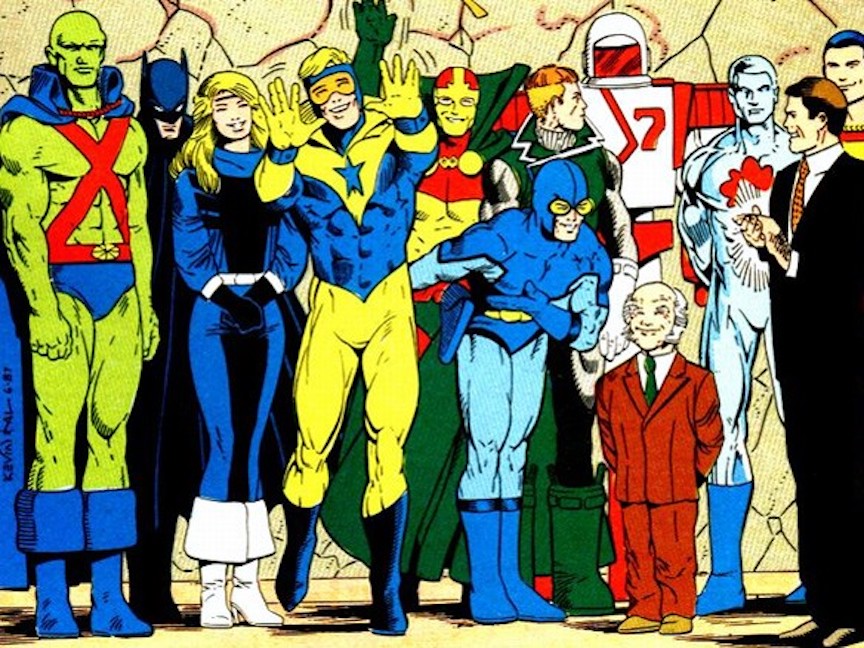Bwa ha ha ha ha ha!
When Crisis on Infinite Earths hit in 1985-1986, the DC Universe was in turmoil. The event was meant to clean up the continuity of the comics universe and, as such, many books had their stories completely wrapped up before the miniseries ended. Justice League of America was one of those books. The team, which had seen a significant drop in the quality of its members over the previous few years, ended up being decimated. With the universe being remade, it needed a new Justice League.
Enter writers Keith Giffen, JM DeMatteis and artist Kevin Maguire.
 Giffen had been sneaking around editor Andy Helfer for a while, telling him he wanted the Justice League book, though when he finally had his wish granted, there were some caveats. Superman, Green Lantern Hal Jordan and Wonder Woman were all unavailable. Barry Allen, The Flash, had just died in the Crisis, so there would be no Flash, either. Giffen and DeMatteis, who was brought in to script Giffen’s plots, had to come up with a new approach for the book, since the major players couldn’t be used.
Giffen had been sneaking around editor Andy Helfer for a while, telling him he wanted the Justice League book, though when he finally had his wish granted, there were some caveats. Superman, Green Lantern Hal Jordan and Wonder Woman were all unavailable. Barry Allen, The Flash, had just died in the Crisis, so there would be no Flash, either. Giffen and DeMatteis, who was brought in to script Giffen’s plots, had to come up with a new approach for the book, since the major players couldn’t be used.
Stalwarts Batman and Martian Manhunter were allowed to stay on the team. The writers filled things out with heavy hitter Captain Marvel, new Green Lantern Guy Gardner, Black Canary, Blue Beetle, Booster Gold, Dr. Light and New God Mister Miracle. The first post-Crisis Justice League story arc, A NEW BEGINNING, established the team as an extension of the United Nations under the supervision of Maxwell Lord, a sleazy businessman who had ulterior motives for controlling the Justice League.
The book quickly established itself as a fan favorite, most notably for one scene, when the hotheaded new Green Lantern challenged Batman for leadership of the team. Batman, in response, knocked Gardner out with one punch.

This led to a chain of events where Gardner hit his head and went from an angry, misanthropic malcontent to a nice guy concerned about the well-being of his teammates. Gardner’s defeat at the hands of Batman and his subsequent transformation set the tone for the book, which became more light-hearted and followed the lives of the team members. To the new creative team, this was more important than putting the team in life-or-death situations with the fate of the universe at stake.
After the book’s first seven issues, it was renamed JUSTICE LEAGUE INTERNATIONAL. It would later be renamed again, this time to JUSTICE LEAGUE AMERICA, as DC also introduced JUSTICE LEAGUE EUROPE and JUSTICE LEAGUE TASK FORCE (and, for one annual, JUSTICE LEAGUE ANTARCTICA).
The JLI “bwa ha ha” era would last until a 16-part crossover between JUSTICE LEAGUE AMERICA and JUSTICE LEAGUE EUROPE called “Breakdowns,” which introduced a more serious tone and new creative teams to both books. But you can’t keep a good concept – or a weed – down, and the JLI and its creative team were a little of both and the JLI team would eventually return, although it would take close to a decade.
Giffen, DeMatteis and Maguire would reunite for a 6-issue special called FORMERLY KNOWN AS THE JUSTICE LEAGUE and it’s sequel (in the pages of anthology series JLA CLASSIFIED), I CAN’T BELIEVE IT’S NOT THE JUSTICE LEAGUE. The two miniseries saw Max Lord bringing together team members like Elongated Man (who just made his TV debut in last week’s episode of THE FLASH) and his wife, Booster Gold, Blue Beetle, Guy Gardner, Fire and Ice, adding Mary Marvel and Power Girl to the mix as the Super Buddies for some fun stories that included alternate dimensions, a trip to hell and a supervillain neighbor.
The creative team tried again to recreate the magic with the recent JUSTICE LEAGUE 3000 series, about a newly-created team 1,000 years in the future, though it never clicked as well.
